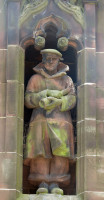
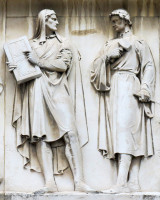
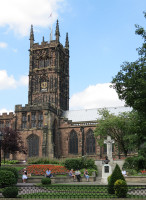
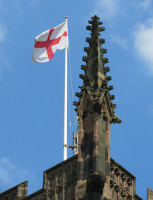

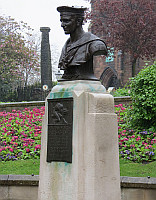
Several pieces of civic sculpture may be found in St Peter’s Gardens also called St Peter's Square, which is the area of gardens around the Collegiate church which provides the centrepiece of the town - see central left picture above.
The church itself is a magnificent building, superbly sited and beautifully coloured in a characteristic red stone – see separate page for the sculptural works inside.
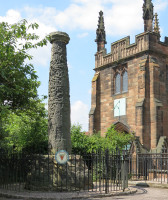
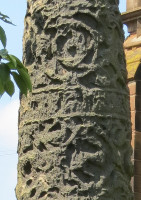 Wolverhampton's Saxon column, and detail of carving.
Wolverhampton's Saxon column, and detail of carving.
The most important piece of sculpture, and one of national significance, is the great Saxon column, believed to have once borne a cross on top, and remnant of a Saxon monastery on the site. A descriptive label by the monument suggests it may originally have been a Roman column brought from Viriconium near Wroxeter (Shropshire), reworked with Saxon carving. The carving is in bands around the column, and at first glance consists simply of a mix of characteristic patterning, but as the eye adjusts and explores the surface, we can discern weird creatures including wolves, birds and mythological animals. These are carved in high relief, and though much weathered, with the right lighting (try looking at different sides of the monument, or at different times of day) it is easy to pick out a range of beasts (click on picture above right to enlarge for example). A 19th Century replica inside the Church, much less weathered, allows a closer look at some of the carving, and it is helpful to look at this replica and then return again to the original outside. Saxon work of this quality and sheer size is rare enough indeed, and a privilege to see.
One of the friezes by R. Boulton, and detail from front to Lichfield St.
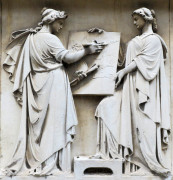
Jumping forward somewhat over a thousand years to Victorian times, we note that the side, and the front, of the Art Gallery bear long friezes of figures, three friezes in all to the St Peter’s Square side, of which one is rather obscured by nearby trees. We see a range of figures in high relief, in modern (late Victorian) fashion, grouped in twos and threes as a mini-pantheon of the arts (facing the front, towards Lichfield Street), and of the manufactures of Wolverhampton. They are of their period, with the men stern and whiskery, and while spare of detail, include some nice character studies. I particularly liked the group of an architect or engineer in his jacket, holding an unrolling scroll, with a heap of others fallen at his feet on a couple of books, while behind him a workman stands by, hand on hip and with a mallet over one shoulder, waiting for a final decision on what to do. The Art Gallery was put up in 1884 to the designs of J. A. Chatwin of Birmingham, a nationally important architect of the period, and the carvers were the Cheltenham firm of Richard Boulton and Company.
Of more or less contemporary date, we come to the large fountain, a typical Victorian thing, massive and solid in pale stone, with three bowls. The highest bowl, simple and without sculptural adornment, rests of the heads of four cherubic figures, each leaning forward and holding hands with his brethren around a central leafy column bearing gargoyle heads. Beneath this, a far larger bowl, carved with a repeating pattern and with an inscription noting that it was put up by public subscription in grateful recognition of the generosity of Philip Horsman This is supported on great beaked dolphins, each facing downward and outward, and supporting the bowl on their curved round tails. As dolphins, they reflect the Classical representation of these beasts rather than anything more recent, and were it not for the beaks, would be more readily seen as sturgeon or some other fish by virtue of their fins rather than flippers. Between them are carved vigorous growths of bulrushes. All this rests on a plinth standing in a pool of red granite. A good civic piece, which although it has the look of a mid-Victorian work, dates from as late as 1894. According to web sources, Farmer and Brindley were the manufacturers. Philip Horsman, a local industrialist in the building trade, supported good works in Wolverhampton, and his firm built the Art Gallery.
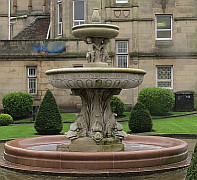
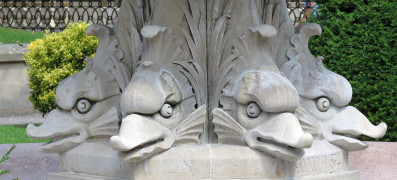 Victorian fountain, and detail of beaked dolphins.
Victorian fountain, and detail of beaked dolphins.
The Great War memorial is an architectural piece, consisting of heavy cross bearing a sculpture of the crucified Christ, a low wall behind and on each side, at the top of a set of steps, all in white Portland stone. The figure of Christ is in a spare, part naturalistic and part stylised mode, characteristic of the 1920s, and has a dignity without sentimentality appropriate for the subject. The Douglas Morris Harris memorial, to a World War I wireless operator who died in the Adriatic sea in 1917, was erected in 1917, consists of a tall stone plinth with a bronze bust on top and a panel on the front and back. The bust shows the youthful Harris, in sailor’s garb, looking straight ahead and with a slightly smiling, optimistic expression. It contrasts with the figure in relief on the front panel, who is shown collapsed over a desk with his signalling apparatus – for, as explained on the plinth, he continued to record wireless messages in the log on his ship in the Adriadic Sea until killed by enemy gunfire, in the year 1917. The sculptor was R. J. Emerson, and he made the sculpture in that year. He was posthumously given an award by the Italian government, and an inscription to this effect, in Italian, is on the second panel, on the Church side of the monument.
Harris Memorial and Crucifix, and details of the former.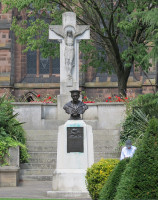
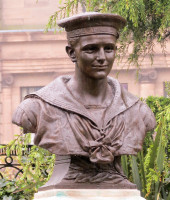
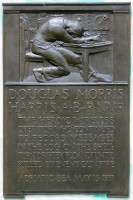
To the western side of St Peter’s towards North Street is a large cenotaph, sympathetically made in the same red-brown local stone as the Church, erected in 1922. It has upon it four statues in niches, depicting a soldier, sailor, airman, and St George. I did not notice a signature, but a web source which gives a full account of the memorial from a War Memorial perspective, http://www.warmem.pwp.blueyonder.co.uk/st-p.htm, states that the sculptor was W. C. H. King, of Hampstead, whose work I am not generally familiar with, but who produced other WW1 memorials at least. The figure sculpture on the Wolverhampton cenotaph are in a style somewhat favoured in the 1920s: rather chunky, not particularly a requirement of the freestone used, and more emblematic than realistic, though having the advantage of being particularly easy to make out from a distance. The one below is the St George (if you like pictures of St George, see this page); a second figure is shown at the top of this page.
World War I monument, and details.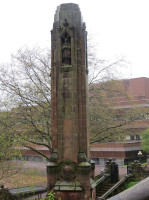

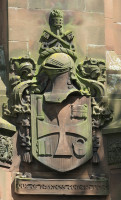
On the same side of the Church is the most recent statue, which is Lady Wulfrun, by Sir Charles Wheeler, a prolific and talented 20th Century sculptor whose work is spread across England, and who studied at Wolverhampton. The statue was presented to Wolverhampton by the Express and Star, to mark the newspaper’s centenary, in 1974. Wulfrun, granddaughter of King Ethelred and great granddaughter of Alfred the Great, was a Saxon noblewoman who is considered as the founder of Wolverhampton.
Lady Wulfrun, founder of Wolverhampton (picture to left shows site by the Church).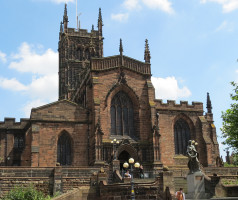
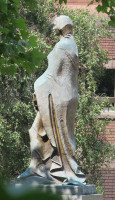


She is shown standing, wearing a typical Saxon robe, clasped at the front with a button or brooch in the shape of a cross, covering her shoulders and pper arms, then opening to reveal her slender figure, garbed in a loose dress down to the ground, and gathered at the high waist by a cord. She holds a charter with a seal dangling from it, in front of her. There is a pleasing symmetry to the figure, but not monotonously so, with a slight variation in the pose of the elegant hands – really aristocratic ones – and with one foot raised on a slight prominence to allow for a variation in the drapery between the two sides of the figure. The face, beneath centre-parted hair tied back under her hood, is youthful, and the neck long. A good thing, far better than many statues of this modern period.
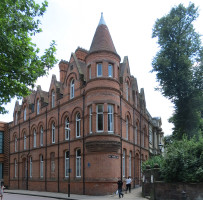
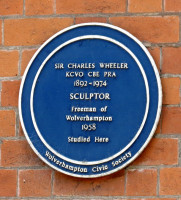 Sir Charles Wheeler's study place and blue plaque.
Sir Charles Wheeler's study place and blue plaque.
Out of chronological sequence, and not part of St Peter’s Gardens, but best viewed from it, is the sculpture on the façade of the former Wolverhampton Technical College, now part of Wolverhampton University. It consists of a pair of male figures, wearing short togas and a slight drape over the shoulder, supporting a cartouche shield which conveniently bears the date, 1933. The stylised bodies are those of athletes, and the faces are rather gaunt, looking older than the figures. Very characteristic of the 1930s. Just along from that building, a blue plaque on the corner notes the study place of Charles Wheeler, who made the Wulfrun statue already referred to.
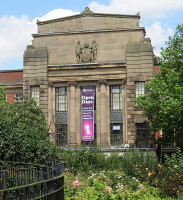
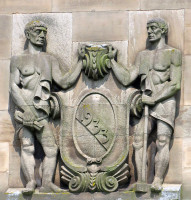 1930s sculpture on former Wolverhampton Technical College.
1930s sculpture on former Wolverhampton Technical College.
Introduction to Wolverhampton sculpture // St Peter's Collegiate Church, Wolverhampton // Queen Square sculpture // Birmingham
Sculpture in some towns in England // Sculpture pages // Introduction to church monuments
Visits to this page from 17 Aug 2014: 1,727 since 9 September 2024